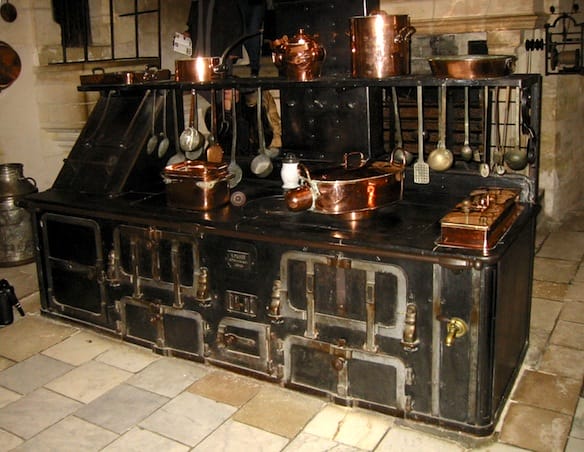
Image credit: Wikipedia.
Home With Your Range
Unless you’re living off the grid someplace and are roasting fresh-killed squirrel with a stick over an open fire, can make do with a hot plate, or have an endless supply of military Meals Ready to Eat (MRE), you’re going to want a range in your kitchen. Rangestypically having four (or more!) burners for stove-top cooking, some kind of oven for baking and roasting, and a place where you broil different kinds of meats and vegetables. Like refrigerators, microwave ovens, and just about every other powered kitchen tool, technology has brought ranges into the twenty-first century. Buying one takes a bit of planning. The result, though, will be a range that’s perfect for you and your needs.
What’s Your Space?
Start the buying process by knowing your available space. It’s likely that you’ll have a designated spot in your kitchen, where natural gas and/or a 220 v. electrical outlet is available. Sometimes your range will require custom installation for a built-in space. More often, you’re range will slide in and out with no drama, and leave the minimum of room to each side where food and liquid might spill. Nothing more unpleasant than having to deal with a rear-burner, hot cereal over-boil that drips to the floor.
Once you’ve got your range sized correctly, and figured your installation requirements, you’ve got options to consider.
Stovetop: Electric or Gas?
Ranges offer two main kinds of stovetop cookery: electric, or natural gas. Each has its plusses. Sometimes, your choice may be dictated by preexisting conditions. If your dwelling is not equipped for natural gas, then electricity will be the way to go.
Electric ranges deliver high-wattage electrical heat to whatever you’re cooking –2,500 watts or more for its large electrical elements, and 1,200 to 1,800 watts for the smaller elements. It’s still possible to find old-style coil-top electric ranges, where the coil is free standing and heats to an intense orange color. Other coils come encase, so there’s no air spaces between the coils.
More and more electric ranges have smooth tops. That is, the heating coils are below a ceramic or strong glass surface that makes contact with the cook wear. Smooth top ranges are attractive, but potentially subject to scratching.
An important variation on the smooth top is the induction range. Induction ranges use subsurface magnetic coils to transmit heat to the cookware. Induction keeps the range surface cooler, but the laws of physics and magnetism require that your cookware be steel or iron.
Gas ranges, on the other hand, burn natural gas. Like electric ranges, they tend to have two large surface units and two medium-size surface units. Also like the latest electric ranges, you might find so-called “gas-on-glass” as an option. That is, the manufacturer will mount the gas burners above a ceramic or glass surface designed for easy cleaning and heat reflection. Tip: With gas ranges, don’t necessarily equate British thermal unit (BTU) capacity and performance. BTU tells you how much gas the burner can handle in an hour. It is not an absolute indicator of how well the unit will perform. However, compared to electricity, gas ranges will be cost effective. They can be up to fifty percent less expensive to operate.
The Oven: Conventional or Convection?
Ovens are for baking and roasting. The most modern ovens can speed that process via convection cookery, where fans inside the oven help to circulate the hot air under, over, and around whatever you’re cooking. Some ovens even come with an extra convection heating element to help the convection system eliminate hot spots and circulate heat more evenly. Convection ovens are efficient – up to a third more energy efficient than conventional ovens. They can take some getting used to, though, if you’re a convection cookery newbie.
Final Tips
Along with how the range performs, think about what it will be like to clean. Many ovens have self-cleaning functions; some are even constantly self-cleaning. If you do a lot of oven cooking, self-cleaning can help you stay away from earth-unfriendly chemicals.
Modern ovens offer many safety-conscious digital controls. Lockout controls let you disable the entire oven so kids and toddlers won’t be tempted to play “Iron Chef.” Touch pads let you set your oven temperature right down to the degree. Timers allow you to delay the start of baking; a hot-surface indicator will tell you whether it’s safe to touch the oven even after the heat has been turned off.
Finally, the job of the stovetop is not just to make things hot, but also to keep them warm. More and more ranges are available with a warming system located between the two sets of burners. Or there might be a “warming drawer” somewhere underneath the oven. Both can be handy, especially when you’re preparing a large meal.



